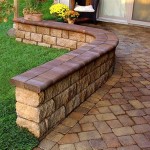Leveling Patio Pavers: The Perfect Finishing Touches
An excellent way to improve the appearance and functionality of your outdoor spaces is by installing patio pavers. However, for a professional-looking finish, the key is achieving an even and stable surface, and this requires careful leveling of the pavers. Leveling also helps prevent shifting and breakage over time, ensuring the longevity of your patio.
Materials You'll Need
- Leveling stakes
- String line
- Rubber mallet
- Leveling bar
- Screed rails (optional but recommended)
- Paver leveling system (optional but highly recommended)
Step 1: Establish a Level Datum
Determine the desired elevation of your patio by using a level and driving a stake into the ground. This will serve as the reference point for the rest of the pavers.
Step 2: Create a Base for the Pavers
Remove any existing grass or vegetation from the patio area and create a stable base by compacting a layer of sand or gravel. Ensure that the base extends at least 6 inches beyond the perimeter of the patio.
Step 3: Install Screed Rails
Optional but highly recommended, screed rails provide a guide to help you level the pavers. Install them parallel to each other, following the level datum you established earlier.
Step 4: Use a Paver Leveling System
Paver leveling systems are designed to lock the pavers together and maintain a uniform surface height. Follow the manufacturer's instructions for installing the spacers and clips.
Step 5: Lay the Pavers
Starting at the level datum, begin laying the pavers in a herringbone or running bond pattern. Use a rubber mallet to tamp them into place. Regularly check the level of the pavers using a level bar and adjust as needed.
Step 6: Screed the Pavers
To ensure a perfectly level surface, use a screed bar. Place the screed bar on the screed rails and slide it along, leveling the pavers to the correct height.
Step 7: Compact the Pavers
Once the pavers are laid and leveled, compact them by tamping or rolling them using a compactor or roller. This step is essential for stabilizing the pavers and preventing movement.
Step 8: Fill the Joints
To prevent weeds and insects from growing between the pavers, fill the joints with sand, polymeric sand, or a specialized joint compound. Ensure the filler is compacted to eliminate any voids.
Tips
- Use a level to ensure accuracy at every step of the process.
- Take your time and don't rush the leveling process.
- If you encounter a slope in your patio area, consider creating a series of steps or a retaining wall.
- Regularly check the level of the pavers after installation to ensure they remain stable.
- Seal the pavers to protect them from the elements and enhance their appearance.
By following these steps and tips, you can achieve a perfectly level patio that enhances the beauty and functionality of your outdoor space. Enjoy the fruits of your labor and create a beautiful and durable patio that will be enjoyed for years to come.

How To Get Your Yard Leveled For Paverspavestone Brick Paving
Dammann S Garden Company Diy Series How To Install Level Pavers And Patio Stones

How To Build A Paver Patio Rogue Engineer

Amazing Diy Paver Patio Using The Brock Base Panel System

Your Complete Guide To Diy Paving N Centre
Dammann S Garden Company Diy Series How To Install Level Pavers And Patio Stones

How To Get Your Yard Leveled For Paverspavestone Brick Paving

How To Build And Lay A Patio Marshalls

How To Build A Paver Patio Young House Love

How To Install A Diy Paver Walkway Scrappy Geek
Related Posts








